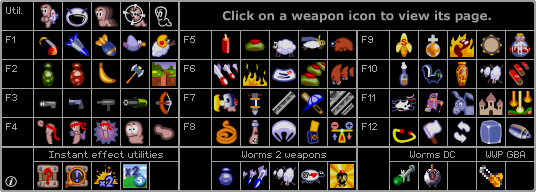Difference between revisions of "Pneumatic Drill"
From Worms Knowledge Base
(probability correction revealed by continued search) |
|||
| Line 60: | Line 60: | ||
* If timed correctly, it is possible to [[Jumping from Pneumatic Drill|jump right after drilling]]. | * If timed correctly, it is possible to [[Jumping from Pneumatic Drill|jump right after drilling]]. | ||
| + | * It's possible to jump off high terrain and activating the drill in the midair. By doing this it's possible to fall down without taking any damage. | ||
== External links == | == External links == | ||
Revision as of 14:25, 5 October 2012
| | |
|---|---|
| Type: | Digging tool |
| Keyboard selection: | F7 (x2) |
| Standard effects: | Vertical tunnel |
| Present in: | W:A, WWP |
| ||||||||||||||||||||||
| Each additional strike by the drill delivers a smaller and smaller amount of injury; each entry in this table shows how the values diminish. |
The Pneumatic Drill allows a worm to dig a hole directly downward through the terrain.
Regardless of power setting, it stays active for a maximum of 5 seconds.
By setting its power, not only the damage caused to a worm changes, but the distance it propels the hit worm too. Also, there is a maximum damage that a worm can recieve during a turn by this weapon.
Its maximum damage is "shared" with the blowtorch, which only matters when RubberWorm's shot doesn't end turn mode is on. This means that the sum of the damage dealt by pneumatic drill and blowtorch in one turn to a single worm can not exceed a certain amount defined by the power setting. In case of different settings, the weaker one is used.
The depth of the hole varies randomly, approximating a Gaussian distribution (bell curve). The average (mean) digging depth, calculated from a test sample of 2.15×1012 random drillings on solid flat terrain, is 157.96 pixels, with a standard deviation of 18.35 pixels (also, the median is 157 and the mode is 156). (The depth is defined as the lowest height a worm can occupy at the bottom of the hole, minus the height of a worm at the surface.) In 95% of drillings, the depth will be within the range 124 to 196 pixels. In 99% of drillings, it'll be from 115 to 208 pixels. In 99.9% of drillings, it'll be from 105 to 223 pixels. The minimum and maximum depths encountered during the test were 63 and 296 pixels, and these are likely to be the absolute limits (suggested by the fact that they exploit patterns in W:A's PRNG). A drill depth of 63 pixels has a probability of 1 in 587,084,635,874, and a 296 pixel depth is 1 in 793,314,991,995. (In contrast, the probability of a 156 pixel depth is 1 in 46.309, or 2.1594%.) If W:A used real randomness and not a PRNG, the minimum depth would be 0 pixels and the maximum would be 792 pixels, but these events would be extraordinarily improbable (less than 1 in 1040).
Note that the above description of drill depth applies to W:A 3.6.29.0 and earlier. A fix in W:A 3.6.30.0 accidentally changed the average depth to 185 pixels (and modified the entire distribution). This will be fixed in W:A 3.6.32.0.
Criticisms, Problems and Weaknesses
- The direction in which a worm is knocked upon being drilled is randomly left or right; contrary to intuition, it does not depend on the relative positions of the worm being drilled and the one doing the drilling.
Tricks and glitches
- If timed correctly, it is possible to jump right after drilling.
- It's possible to jump off high terrain and activating the drill in the midair. By doing this it's possible to fall down without taking any damage.
